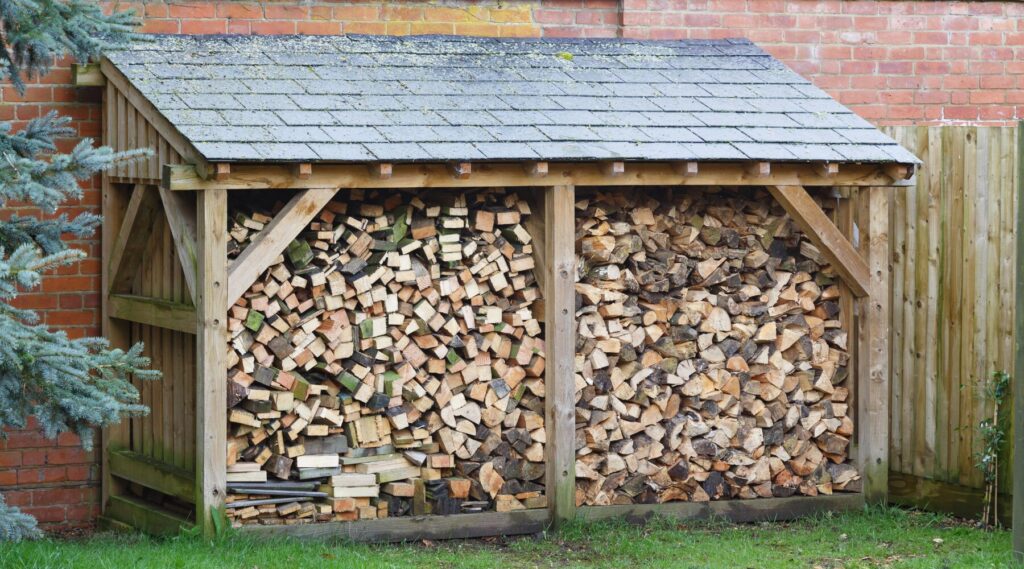The British winter presents unique challenges for wood storage, with its combination of persistent dampness, frequent rainfall, and fluctuating temperatures. Whether you’re heating your home with a wood-burning stove or maintaining supplies for an outdoor fire pit, proper wood storage is essential for maintaining fuel quality and ensuring efficient burning throughout the colder months.
Understanding Wood Types and Storage Requirements
Different types of wood require varying approaches to storage, particularly during the harsh UK winter months. Kiln dried logs represent the premium option for winter storage, having already undergone controlled drying processes that reduce moisture content to optimal levels. These logs typically contain less than 20% moisture and offer immediate burning efficiency, making them ideal for homeowners who need reliable, ready-to-burn fuel during unpredictable winter weather.
Hardwood logs, including oak, ash, and beech varieties, are prized for their long burn times and high heat output. However, they require more careful storage consideration during winter months. Hardwoods are denser and take longer to season naturally, meaning proper protection from winter moisture becomes crucial. When storing hardwood logs outdoors during UK winters, ensuring adequate air circulation while maintaining protection from direct rainfall is essential for preventing moisture reabsorption.
Softwood logs, such as pine, fir, and spruce, burn more quickly than hardwoods but are excellent for kindling and quick heat generation. These woods are more susceptible to moisture absorption during winter storage, requiring vigilant protection from the elements. Softwood logs benefit significantly from covered storage solutions that allow airflow while preventing direct contact with rain and snow.
Essential Winter Storage Infrastructure
An Outdoor Log Store represents one of the most effective solutions for UK winter wood storage. Purpose-built log stores provide the perfect balance of weather protection and ventilation that British winters demand. When selecting an outdoor log store, prioritize designs that feature slanted roofs for optimal water runoff, raised floors to prevent ground moisture absorption, and open sides that promote crucial air circulation.
The positioning of your outdoor log store significantly impacts its effectiveness during winter months. Choose locations that receive some natural wind exposure to aid drying but avoid areas prone to driving rain or snow accumulation. South-facing positions often work well, as they maximize available winter sunlight while providing natural protection from prevailing westerly winds common across the UK.
Moisture Management Strategies
UK winters are notoriously damp, making moisture management the cornerstone of successful wood storage. Even the highest quality kiln dried logs can reabsorb moisture if improperly stored during wet winter months. Create barriers between wood and ground contact using pallets, treated timber, or purpose-built platforms that elevate logs at least six inches above ground level.
Implement layered storage approaches that maximize air circulation between logs. Stack wood with small gaps between pieces, allowing winter air to flow freely and prevent moisture buildup that leads to rot and fungal growth. Avoid creating solid walls of stacked wood, which trap moisture and create perfect conditions for decay during long winter periods.
Consider the microclimate around your storage area. Buildings, fences, and trees can create wind shadows or moisture traps that affect wood storage conditions. During UK winters, areas that remain perpetually damp or receive minimal airflow should be avoided for wood storage, regardless of how convenient they might seem.
Covering and Protection Methods
Proper covering techniques are crucial for protecting wood during UK winter weather while maintaining essential ventilation. Traditional tarpaulins can work effectively when properly secured, but ensure covers don’t create sealed environments that trap moisture. Leave gaps at the bottom of covers to allow air circulation while protecting the top and sides from direct precipitation.
Purpose-built log store covers or shed structures offer superior protection for serious wood users. These solutions provide comprehensive weather protection while incorporating design features that promote air circulation. Many modern outdoor log stores include ventilation strips or gaps specifically designed to maintain airflow during winter storage periods.
For temporary or budget-conscious solutions, corrugated metal sheets or outdoor fabric covers can provide adequate protection when properly supported and secured. Ensure any covering solution allows for air movement underneath while preventing pooling of rainwater or snow that could create localized moisture problems.
Seasonal Storage Planning
UK winter wood storage requires forward-thinking seasonal planning. Begin preparing winter storage solutions during late summer or early autumn, before weather conditions become challenging. This timing allows for proper setup of storage infrastructure and initial wood placement during drier conditions.
Rotate wood stocks regularly throughout winter, using older supplies first while maintaining optimal storage conditions for remaining logs. This rotation prevents any single batch of wood from remaining in storage too long, reducing the risk of quality degradation during extended winter periods.
Monitor weather forecasts and adjust storage practices accordingly. Severe weather warnings might necessitate additional protection measures or temporary relocation of exposed wood supplies. Having contingency plans for extreme weather events ensures continuous fuel availability throughout even the harshest UK winters.
Indoor Storage Considerations
While outdoor storage often handles bulk wood supplies, strategic indoor storage provides immediate access to dry fuel during winter weather. Dedicated indoor storage areas should maintain low humidity and good ventilation to prevent moisture problems within living spaces.
Bring small quantities of wood indoors during severe weather periods, allowing logs to reach room temperature before burning. This practice ensures optimal combustion and heat output while reducing the need to venture outside during harsh winter conditions.
Common Winter Storage Mistakes
Avoid creating completely enclosed storage environments that eliminate air circulation. While protection from weather is essential, completely sealing wood from air movement creates perfect conditions for moisture retention and fungal growth during UK winters.
Never store wood directly on ground surfaces, particularly during winter months when ground moisture levels remain consistently high. Even brief contact with wet ground can compromise wood quality and create ongoing moisture problems.
Resist the temptation to overpac storage areas. Dense packing prevents air circulation and creates moisture traps that become problematic during long winter storage periods.
Conclusion
Successful wood storage during UK winters requires balancing weather protection with adequate ventilation, choosing appropriate storage solutions for different wood types, and implementing proactive moisture management strategies. Whether using kiln dried logs for immediate burning, storing hardwood logs for long-term heat, managing softwood logs for kindling, or investing in a quality outdoor log store, proper winter storage techniques ensure reliable fuel supplies throughout the challenging British winter months.
By implementing these comprehensive storage strategies, homeowners can maintain high-quality wood fuel supplies that burn efficiently and provide consistent heat throughout even the most demanding UK winter conditions.











